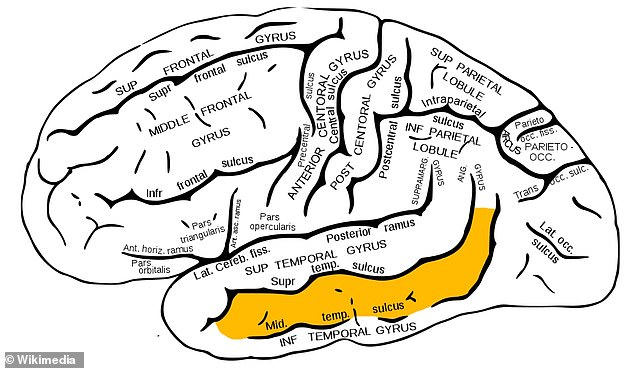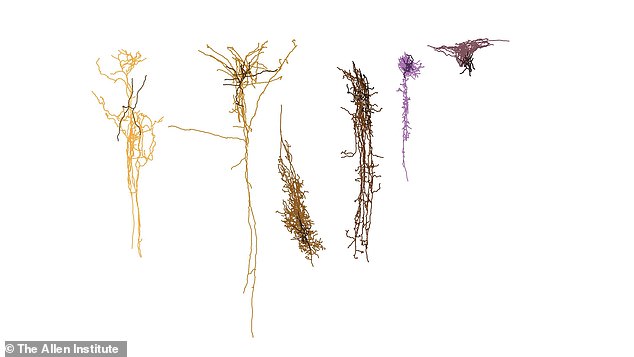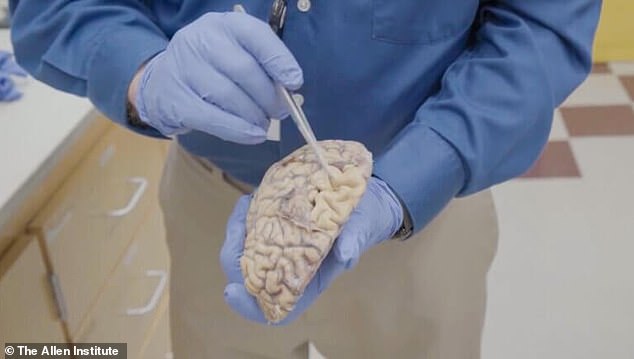Alzheimer’s occurs in two distinct stages, scientists have shown for the first time.
The first stage involves subtle changes in an overlooked area of the brain and occurs decades before symptoms appear.
The second stage is rapid and includes massive cell death and the accumulation of protein bundles that affect memory and speech.
Scientists say there is a crucial window between these two stages to detect and stop the disease before it really spreads.
Dr. Richard Hodes, director of the NIH Institute on Aging, which funded the study, said: “The results fundamentally alter scientists’ understanding of how Alzheimer’s damages the brain and will guide the development of new treatments for this devastating disorder.”
A doctor at the Allen Institute showed that the brain folds of a person with advanced dementia are more widely spaced than in a healthy brain, which is evidence of tissue loss.

In 2022, Chris Hemsworth discovered that he was genetically predisposed to Alzheimer’s and made this information public. The discovery hasn’t stopped the action star from continuing to work.
He added: “The ability to detect these early changes means that, for the first time, we can see what happens to a person’s brain during the early periods of the disease.”
About 7 million Americans currently live with Alzheimer’s and those cases are expected to increase to 13 million by 2050, in part due to the aging population, according to the alzheimer’s association.
Approximately one in five women suffers from the disease and one in ten men. In 2022, Marvel actor Chris Hemsworth, 40, discovered he was likely to develop the disease, after undergoing genetic testing.
He has become a public figure in the fight against dementia. This includes sharing details about your health and wellness routines and encouraging others to attend regular doctor visits.
Despite how common the disease is, there are many things that science does not understand What causes dementia and how it progresses.
This new study published by researchers at the University of Washington and the NIH Allen Institute for Brain Sciences, in the Nature Neuroscience magazineadds a completely new theory to the field.
They studied more than 3.4 million individual cells from the brains of 84 deceased donors, from a part of the brain called the middle temporal gyrus.
This region is crucial in both language and memory processing, and previous research has suggested that it is one of the first to fail in dementia.
They compared the unhealthy cells with those from previous research of healthy individuals using a complex computer algorithm.
They discovered that there are two main phases of Alzheimer’s disease.
The first phase occurs silently, with subtle changes in the cells that protect neurons, increased inflammation, and minor cell loss.
This happens over a long period of time and does not affect the person’s memory.
Dr. Igor Carmargo Fontana, director of scientific conference programming at the Alzheimer’s Association he told Fox News These changes could begin decades before anyone is noticeably affected.
The second stage is fast and brutal: it is characterized by the rapid formation of large protein plaques that crowd healthy brain tissue and suffocate it.
This coincides with the period when someone begins to lose memory and cognition. It is unclear what is driving these changes.
In normal aging, the brain slowly loses some volume over time, but it is not specific to certain cell types nor does it change pace rapidly, as occurs in dementia. Furthermore, the protein plaques seen in dementia do not appear as widely in normal aging.

The researchers studied cells from the temporal gyrus, a region found near the base of the brain and is crucial in language and memory.

Researchers were surprised to discover that a type of cell that is important for disrupting signaling in the brain was one of the first to die. Other types of cells, such as those that insulate and feed nerves, were also affected early on
The two-phase model contrasts with what researchers previously thought: that the disease takes over the brain in a many-step process.
Study author and neuropathologist Mariano Gabitto said: “You could say that we have created a pathology clock that indicates not only what changes are occurring in this cortical region, but also when.”
The researchers wrote that focusing on these subtle changes in the early stage could help them develop treatments for the disease before it begins to affect memory.
In particular, they were surprised to discover that one type of cell seemed to give in first: so-called somatostatin-expressing inhibitory neurons.
These cells are important for controlling how the brain activates and are crucial for things like attention.
In the first phase, the researchers discovered that brain inflammation eliminates these cells.
Future studies can investigate how to protect these cells and others from death to stop the memory-stealing disease before it reaches the second stage, said Dr. John Ngai, director of the BRAIN Institute.
Dr Ngai added: “The new insights provided by this study can help scientists and drug developers around the world develop diagnostics and treatments targeting specific stages of Alzheimer’s and other dementias.”

